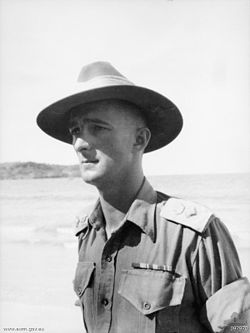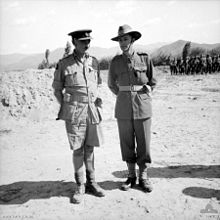- Charles Hercules Green
-
Charles Hercules Green 
Charles Green in Wirui, New Guinea 1945Nickname 'Chuckles' Born 26 December 1919
Grafton, AustraliaDied 1 November 1950 (aged 30)
Anju, KoreaBuried at Pusan, South Korea Allegiance  Australia
AustraliaService/branch Australian Army Years of service 1936–1950 Rank Lieutenant Colonel Commands held 2/11th Battalion
3rd Battalion, Royal Australian RegimentBattles/wars - Battle of Yongju
- Battle of Kujin
- Battle of Chongju
Awards Distinguished Service Order
Silver Star (United States)Lieutenant Colonel Charles Hercules Green DSO (26 December 1919 – 1 November 1950) was a senior officer in the Australian Army. He served as a battalion commander in World War II, and again later during the Korean War, where he was killed in action while commanding the 3rd Battalion, Royal Australian Regiment.[1] He was the youngest battalion commander in the Second AIF, and was reputed to have been one of the Australian Army's better unit-level commanders.[2]
Contents
Early life
Born on 26 December 1919 at Grafton, New South Wales, Charles Green was the second of three children to Hercules John Green and Bertha Deville, and was raised at Swan Creek. He attended school at Swan Creek Public School and Grafton High School. In 1933, he began working for his father on the family dairy farm.[1]
Military career
Early service
On 28 October 1936, at the age of 16, he enlisted in the 41st Battalion, a militia unit, and was promoted to sergeant in 1938 and lieutenant in March 1939.[1]
World War II
With the outbreak of World War II, he enlisted in the 2nd AIF on 13 October 1939 and was posted to the 2/2nd Battalion.[1] The 2/2nd Battalion was subsequently deployed to the Middle East in February 1940, however Green missed out on the North African campaign between December 1940 and January 1941 due to accidentally injuring himself. The battalion was later committed to Greece, where Green participated in the fighting at Pineios Gorge on 18 April. In the subsequent retreat from Greece he evaded capture by undertaking a hazardous journey through the Aegean Islands, through Turkey, and reached Palestine on 23 May.[1]
Green's battalion then was sent to undertake garrison duties in Syria and Ceylon, before finally returning to Australia in August 1942. Again he could not participate with the battalion in the New Guinea campaign as he had injured his foot and contracted typhoid whilst in Ceylon. Posted as an instructor to the First Army's Junior Tactical School, Southport, Queensland, in December. He married Edna Olwyn Warner at St Paul's Anglican Church, Ulmarra, New South Wales on 30 January 1943.[1]
Promoted to temporary lieutenant colonel on 9 March 1945 and given command of the 2/11th Battalion, and at the age of only 25 he was the youngest Australian battalion commander during the war.[3] The battalion then took part in the attack on Wewak and operations around Boram[1] during 1945. Conditions were difficult, and during the early part of the campaign supply lines were constantly raided by the Japanese causing difficulty with rations and creature comforts. Later the battalion suffered significant casualties, but still Green managed to maintain morale and efficiency—all objectives assigned to the unit during the campaign were achieved. As a result he was later awarded the Distinguished Service Order.[Note 1]
Post World War II
After discharging on 23 November 1945, he returned to Grafton where he worked at the Producers' Co-operative Distributing Society Ltd and studied accountancy. During this time he and his wife had a daughter, Anthea.[4] He returned to the 41st Battalion as part of the Citizens Military Forces when it reformed in April 1948 as its commander, while on 6 January 1949 he again joined the Regular Army.[1] In 1950 he was selected to attend Staff College.[4]
Korean War
 Green (right) with Brigadier Basil Coad, commander of 27th British Commonwealth Brigade, at Taegu, Korea, 28 September 1950
Green (right) with Brigadier Basil Coad, commander of 27th British Commonwealth Brigade, at Taegu, Korea, 28 September 1950
After the 3rd Battalion, Royal Australian Regiment was committed to the Korean War, he was appointed the Commanding Officer in September 1950. After only two weeks training the battalion was sent to Korea where it formed part of 27th British Commonwealth Brigade. Leading the battalion with distinction through the battles at Yongju, Kujin, and Chongju he was severely wounded by a shell burst while resting in his tent. He could not be saved, however, and died the next day in a nearby US Army Mobile Army Surgical Hospital at Anju.[5] He was posthumously awarded the Silver Star and was buried in the United Nations War Cemetery in Pusan, South Korea.[1][6]
Notes
- Footnotes
- ^ Green's brigade commander, Brigadier J. Martin, recommended him for appointment as Officer of the Order of the British Empire, this was endorsed by Major General Horace Robertson, commanding 6th Division, upgraded to the Distinguished Service Order by Lieutenant General Vernon Sturdee of First Army, this recommendation was in turn endorsed by General Thomas Blamey, Commander-in-Chief, Australian Military Forces, and Green was duly awarded the DSO on 6 March 1947. See "Recommendations for Honours and Awards (Army)—Image details—Green, Charles Hercules" (fee usually required to view pdf of full original recommendation). DocumentsOnline. The National Archives. http://www.nationalarchives.gov.uk/documentsonline/details-result.asp?Edoc_Id=7674536. Retrieved 24 September 2009. and London Gazette: (Supplement) no. 37898. p. 1089. 4 March 1947. Retrieved 23 September 2009.
- Citations
- ^ a b c d e f g h i Australian Dictionary of Biography 1996, pp. 313–314.
- ^ Butler, Argent and Shelton 2002, p. 39.
- ^ Butler, Argent and Shelton 2002, p. 41.
- ^ a b Butler, Argent and Shelton 2002, p. 49.
- ^ Odgers 2009, p.48.
- ^ London Gazette: (Supplement) no. 39265. p. 3411. 19 June 1951. Retrieved 23 August 2009.
References
- Butler, David; Alf Argent and Jim Shelton (2002). The Fight Leaders: Australian Battlefield Leadership: Green, Hassett and Ferguson 3RAR – Korea. Loftus: Australian Military Historical Publications. ISBN 1876439564.
- Barter, Margaret (1996). "Green, Charles Hercules (1919 - 1950)". Australian Dictionary of Biography. 14. Melbourne: Melbourne University Press. ISBN 052284717X. http://www.adb.online.anu.edu.au/biogs/A140357b.htm.
- Odgers, George (2009). Remembering Korea: Australians in the War of 1950–53. Chatswood: New Holland Publishers (Australia). ISBN 9781741108071.
Categories:- 1919 births
- 1950 deaths
- Australian Army officers
- Australian military personnel of World War II
- Australian military personnel of the Korean War
- Companions of the Distinguished Service Order
- People from Grafton, New South Wales
- Recipients of the Silver Star
Wikimedia Foundation. 2010.
